Bruce R. Rosendahl Named Dean of the Rosenstiel School 1989
Christopher Harrison Named Interim Dean of the Rosenstiel School 1987
Science and Administration Building Commissioned 1982
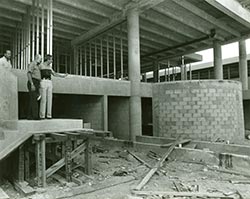
Dr. Alan Berman, assumed the post of Dean of the Rosenstiel School in 1982. Here he checks the progress of the construction of the Science and Administration Building.
Alan Berman Named Dean of the Rosenstiel School 1982
R/V Cape Florida Assigned to UM 1981
The National Science Foundation assigned the coastal zone research vessel Cape Florida to UM.
Warren J. Wisby Named Dean of the Rosenstiel School 1980
Enormous Lemon Shark Study Conducted 1979
Led by Dr. Samuel Gruber, a study of the role of lemon sharks as predators began. The research involved measuring, marking and releasing 1,000 lemon sharks—then monitoring their movement and behavior.
30-year Carbon and Oxygen Isotope Analysis Study Published
Dr. Cesare Emiliani and colleagues publish a paper in Nature about carbon and oxygen isotope analysis through a 30-year study of the growth of Montastraea annularis, a milestone in the study of Isotopic Paleotemperatures and Geochronology
The Cooperative Institute for Marine and Atmospheric Studies established 1977
Created to promote concentrated research on specific problems of the ocean and atmosphere, CIMAS brought together researchers from the Rosenstiel School, NOAA and scientists visiting from around the world.
William W. Hay named Dean of the Rosenstiel School 1976
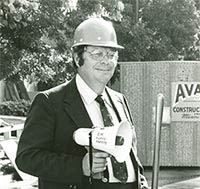 Dr. William W. Hay directs the groundbreaking for a wing added to the Marine Science Center for the new UM - NOAA Cooperative Institute for Marine and Atmospheric Studies.
Dr. William W. Hay directs the groundbreaking for a wing added to the Marine Science Center for the new UM - NOAA Cooperative Institute for Marine and Atmospheric Studies.
GATE project Launched to Study Equatorial Undercurrent 1974
The Rosenstiel School participated in a joint oceanographic and atmospheric research study that involved 40 vessels from nations around the world. Two of the school’s principal research vessels were involved in the six-month observational study.
Warren S. Wooster named Dean of the Rosenstiel School 1973
Dual Doppler Radar Facilities Installed 1972
Pioneered by Dr. Roger Lhermitte, the development and installation of dual Doppler radar facilities made possible for the first time the observation of wind fields inside storms. The School’s new dual doppler brought international attention to its capabilities.
Fisher Island Laboratory Opened 1972
Former U.S. Quarantine station on Fisher Island was acquired by UM, and converted into the Comparative Sedimentology Laboratory, led by Robert Ginsburg.
Dr. Walton Smith Retired 1972
Thirty years since he had joined the University of Miami and started the first Marine Lab, Dr. Walton Smith announced his retirement.
New Reefs Uncovered 1970-1973
UM scientists discover a new class of reefs in Bermuda that are constructed by coralline algae and sessile gastropods and rapidly thoroughly lithified by precipitation of calcium carbonate from sea water.
Commandant Jacques-Yves Cousteau helps dedicate the Marine Science Center 1971
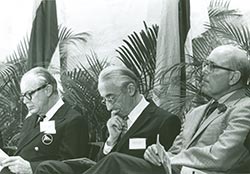 The $2.1 million Henry L. Doherty Marine Science Center was formally dedicated on February 26, 1971. Commandant Jacques-Yves Cousteau, director of the Institut Oceánographique in Monaco, was one of the guest speakers. Seated with Commandant Cousteau on the platform were Dean F.G. Walton Smith (left) and UM President Henry King Stanford.
The $2.1 million Henry L. Doherty Marine Science Center was formally dedicated on February 26, 1971. Commandant Jacques-Yves Cousteau, director of the Institut Oceánographique in Monaco, was one of the guest speakers. Seated with Commandant Cousteau on the platform were Dean F.G. Walton Smith (left) and UM President Henry King Stanford.
Rosenstiel School Commissions the Construction of R/V CALANUS 1970
After 30 years of using temporary and converted ships as research vessels, the School was finally able to fund the construction of a 62-foot research vessel specifically for its oceanographic work. At the commissioning of R/V CALANUS in 1970, Lewis Rosenstiel (wearing hat) joined Dean and Mrs. Smith on the dock for the ceremony.
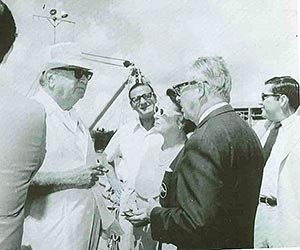
Deep-Sea Drilling Expedition for Sediments led to Oil Discovery 1969
An ambitious deep-sea drilling expedition led by the Institute’s Geology Division resulted in an unparalleled collection of sediments. In addition, a major discovery was the appearance of oil while drilling at 12,000 feet in the Gulf of Mexico.
Institute for Marine Science Renamed to the Dorothy and Lewis Rosenstiel School of Marine and Atmospheric Science 1969
The Institute of Marine Science was formed into a school in 1969, and named the Dorothy and Lewis Rosenstiel School of Marine and Atmospheric Science in recognition of a major gift from the Rosenstiel Foundation.
Sea Grant Project Launched 1968
Located at Turkey Point, the Sea Grant Project was an aquaculture project initiated between the Institute of Marine Sciences and private corporations for the purpose of developing the cultivation of shrimp and pompano. Seven ponds were constructed for the studies.
Division of Ocean Engineering Established 1965
Grosvenor North Wing Completed 1965
With funds from the National Science Foundation, the north wing was constructed, and was later named for Gilbert Hovey Grosvenor, president of the National Geographic Society from 1920 to 1954. A winter resident of Coconut Grove, he had frequently visited the Marine Lab.
Controlled Environment Laboratory Opened 1963
The Alfred C. Glassell, Jr. Controlled Environment Laboratory opened its doors, funded with donations from private benefactors, as well as the National Science Foundation
New Research Vessels Acquired 1963
The 176-foot R/V John Elliott Pillsbury was commissioned, and a 65-foot T-boat was acquired from the US govenment, and named Tursiops.
First Bioacoustics Program Began 1962
Hydrophones and an underwater TV camera were installed on a reef one mile off the west bank of Bimini, Bahamas. The system was used to record animal sounds, and allowed the playback of sounds to the reef. This marked the beginning of the bioacoustics program at the Rosenstiel School.
Division of Physical Science Created 1961
The Division of Physical Science was established, with Dr. Fritz Koczy as its chairman. Dr. Koczy, an Austrian scientist whose research covered the entire field of oceanography, was largely responsible for the highly successful development of the Division during the 1960s.
Campus Expansion 1961
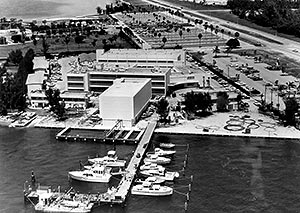 After almost twenty years, the UMML was progressing in every respect so the University reorganized it in 1961 as the Institute of Marine Science with three academic and research divisions. In the mid-sixties, the Virginia Key campus looked like this with the new controlled environment building (Glassell Laboratory) and its pens for sharks on the waterfront, and the physical sciences wing (Grosvenor North) completed. A temporary building housed some offices until the hoped-for Marine Science Center could be built.
After almost twenty years, the UMML was progressing in every respect so the University reorganized it in 1961 as the Institute of Marine Science with three academic and research divisions. In the mid-sixties, the Virginia Key campus looked like this with the new controlled environment building (Glassell Laboratory) and its pens for sharks on the waterfront, and the physical sciences wing (Grosvenor North) completed. A temporary building housed some offices until the hoped-for Marine Science Center could be built.
Tritium Laboratory Created 1960
Established as a radiocarbon dating facility for ocean waters and sediment, the Laboratory was started by Dr. Gote Ostlund and was the first of its kind in the world that monitored tritium levels and radiocarbons in the environment. Contaminated tritiated water from the nuclear tests was found to spread like a dye on the upper layers of the ocean.
SCUBA Expands Research Capabilities 1960
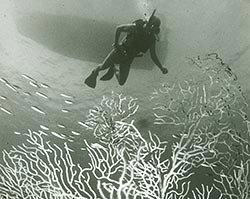 When SCUBA replaced the diving helmets of the forties, IMS scientists found a new freedom to make direct observations of the complex coral reef environment. Dr. Richard Robins directed a NSF study of the feeding behavior of the Florida's coral reef fishes that involved day and night diving by three Ph.D. candidates, Walter Starck, Henry Feddern, and Bill Davis.
When SCUBA replaced the diving helmets of the forties, IMS scientists found a new freedom to make direct observations of the complex coral reef environment. Dr. Richard Robins directed a NSF study of the feeding behavior of the Florida's coral reef fishes that involved day and night diving by three Ph.D. candidates, Walter Starck, Henry Feddern, and Bill Davis.




 Dr. William W. Hay directs the groundbreaking for a wing added to the Marine Science Center for the new UM - NOAA Cooperative Institute for Marine and Atmospheric Studies.
Dr. William W. Hay directs the groundbreaking for a wing added to the Marine Science Center for the new UM - NOAA Cooperative Institute for Marine and Atmospheric Studies. The $2.1 million Henry L. Doherty Marine Science Center was formally dedicated on February 26, 1971. Commandant Jacques-Yves Cousteau, director of the Institut Oceánographique in Monaco, was one of the guest speakers. Seated with Commandant Cousteau on the platform were Dean F.G. Walton Smith (left) and UM President Henry King Stanford.
The $2.1 million Henry L. Doherty Marine Science Center was formally dedicated on February 26, 1971. Commandant Jacques-Yves Cousteau, director of the Institut Oceánographique in Monaco, was one of the guest speakers. Seated with Commandant Cousteau on the platform were Dean F.G. Walton Smith (left) and UM President Henry King Stanford.
 After almost twenty years, the UMML was progressing in every respect so the University reorganized it in 1961 as the Institute of Marine Science with three academic and research divisions. In the mid-sixties, the Virginia Key campus looked like this with the new controlled environment building (Glassell Laboratory) and its pens for sharks on the waterfront, and the physical sciences wing (Grosvenor North) completed. A temporary building housed some offices until the hoped-for Marine Science Center could be built.
After almost twenty years, the UMML was progressing in every respect so the University reorganized it in 1961 as the Institute of Marine Science with three academic and research divisions. In the mid-sixties, the Virginia Key campus looked like this with the new controlled environment building (Glassell Laboratory) and its pens for sharks on the waterfront, and the physical sciences wing (Grosvenor North) completed. A temporary building housed some offices until the hoped-for Marine Science Center could be built. When SCUBA replaced the diving helmets of the forties, IMS scientists found a new freedom to make direct observations of the complex coral reef environment. Dr. Richard Robins directed a NSF study of the feeding behavior of the Florida's coral reef fishes that involved day and night diving by three Ph.D. candidates, Walter Starck, Henry Feddern, and Bill Davis.
When SCUBA replaced the diving helmets of the forties, IMS scientists found a new freedom to make direct observations of the complex coral reef environment. Dr. Richard Robins directed a NSF study of the feeding behavior of the Florida's coral reef fishes that involved day and night diving by three Ph.D. candidates, Walter Starck, Henry Feddern, and Bill Davis.